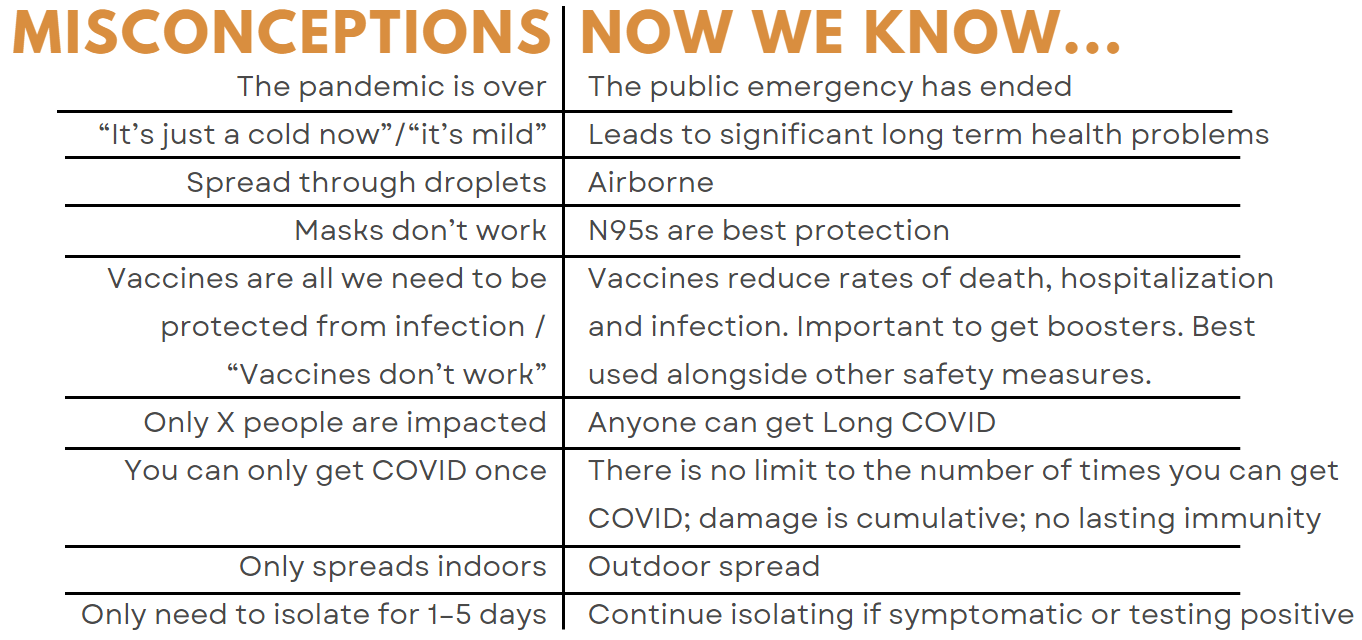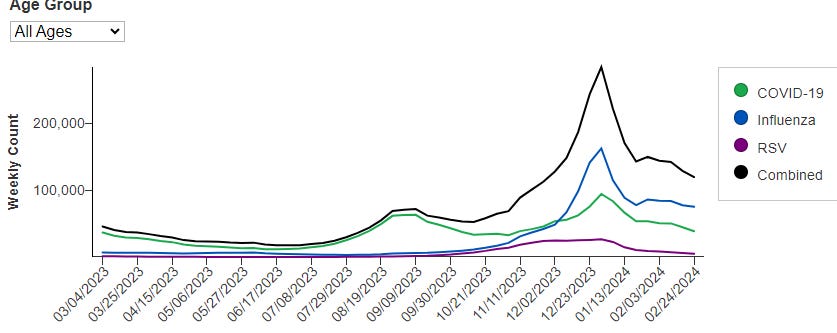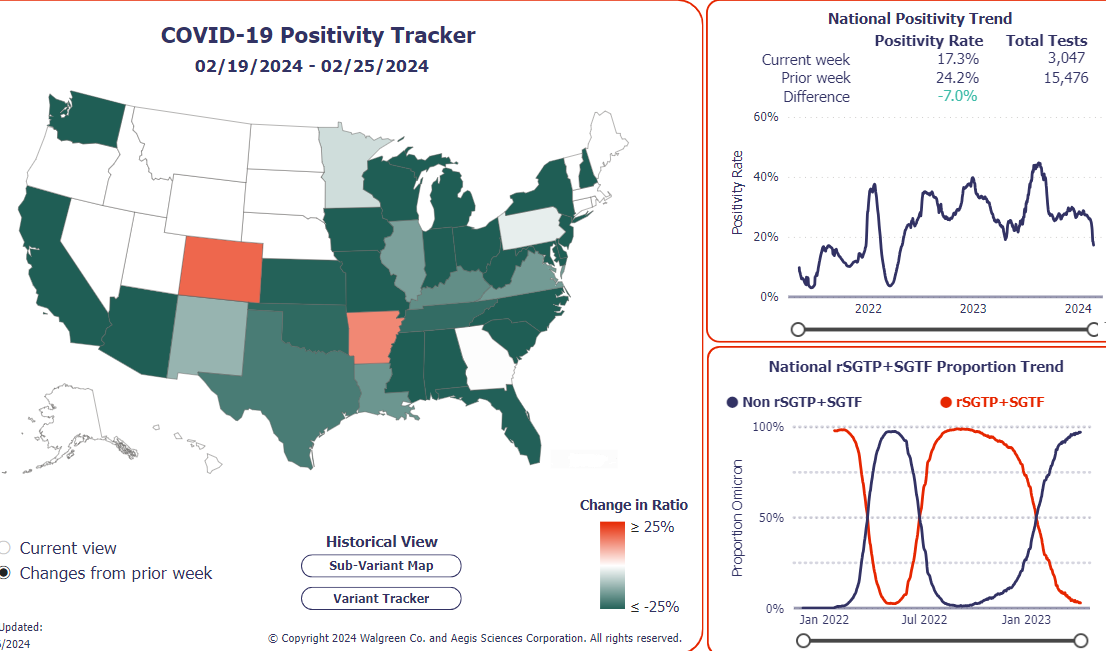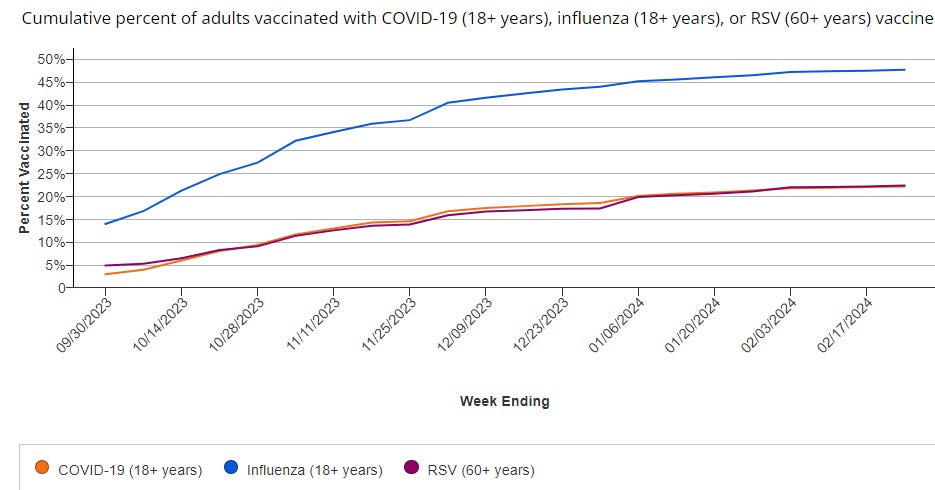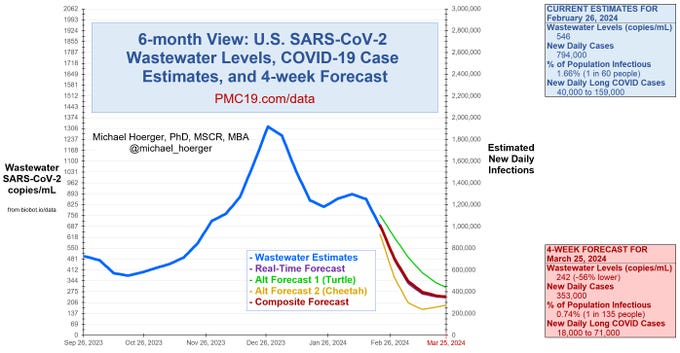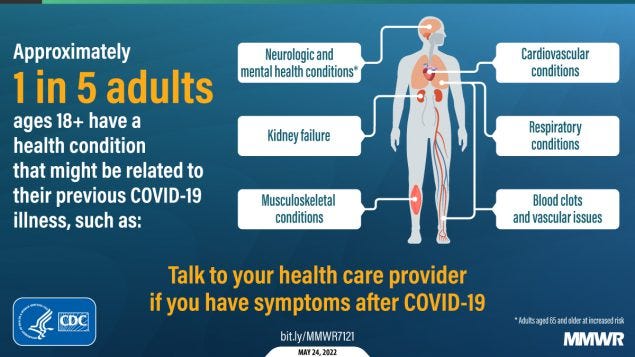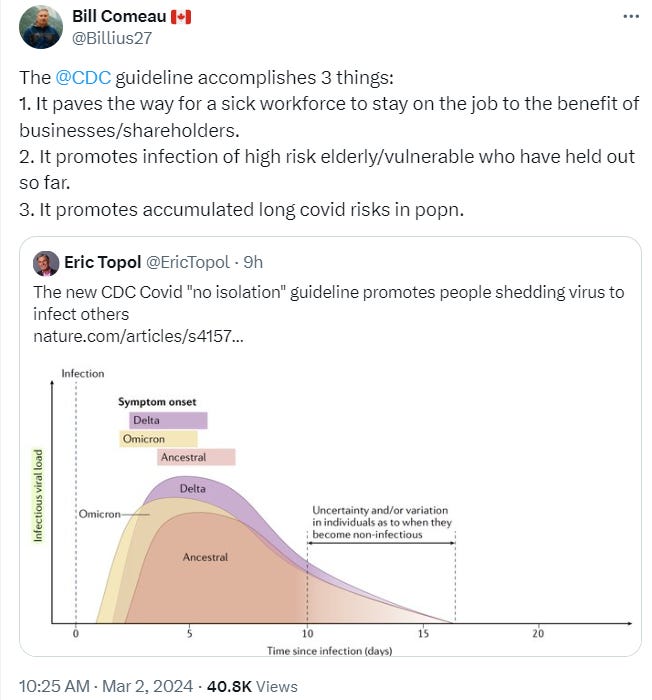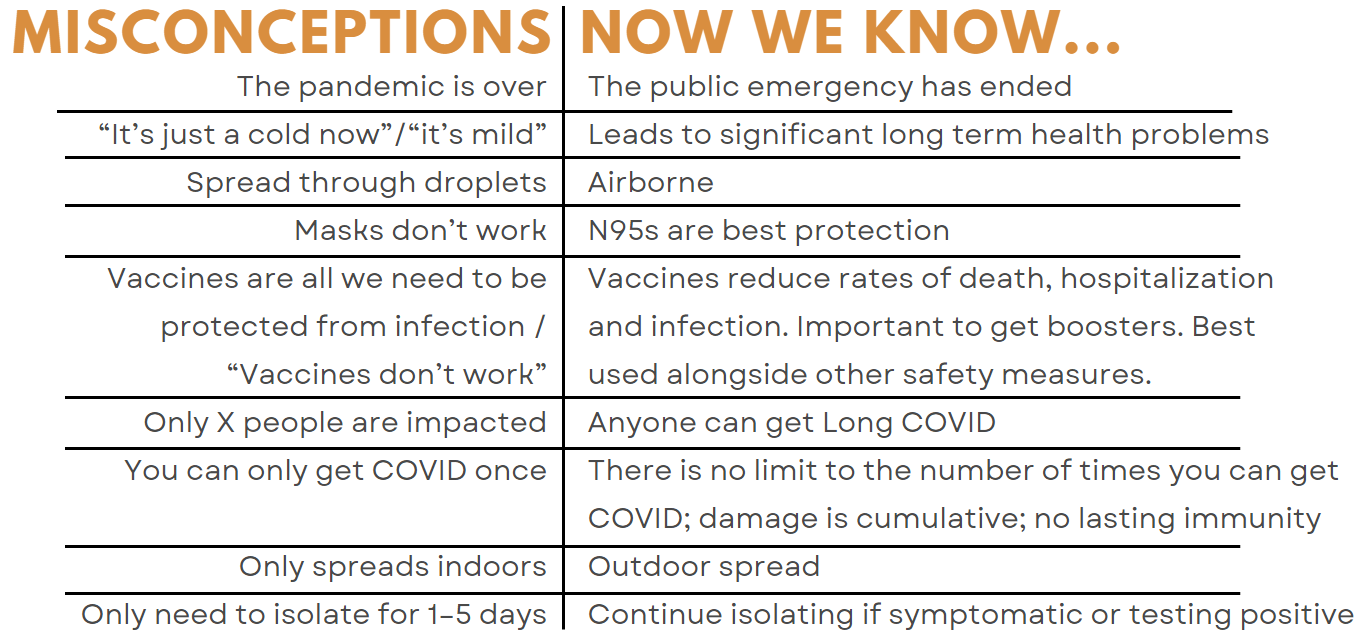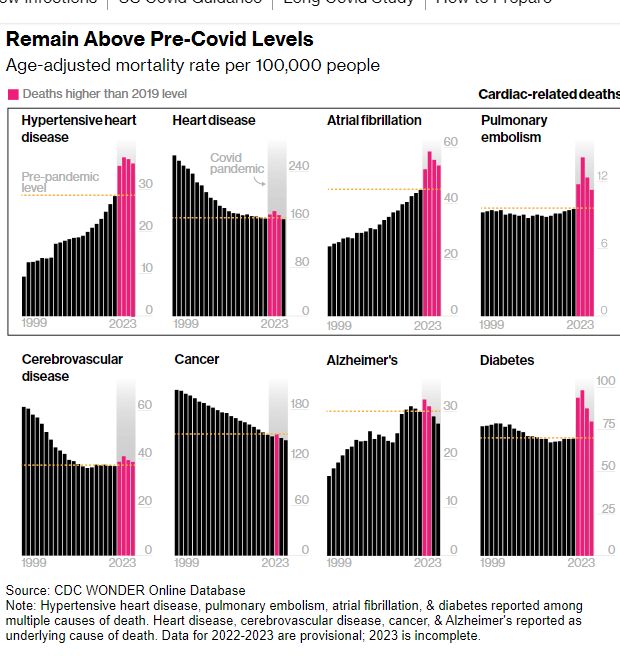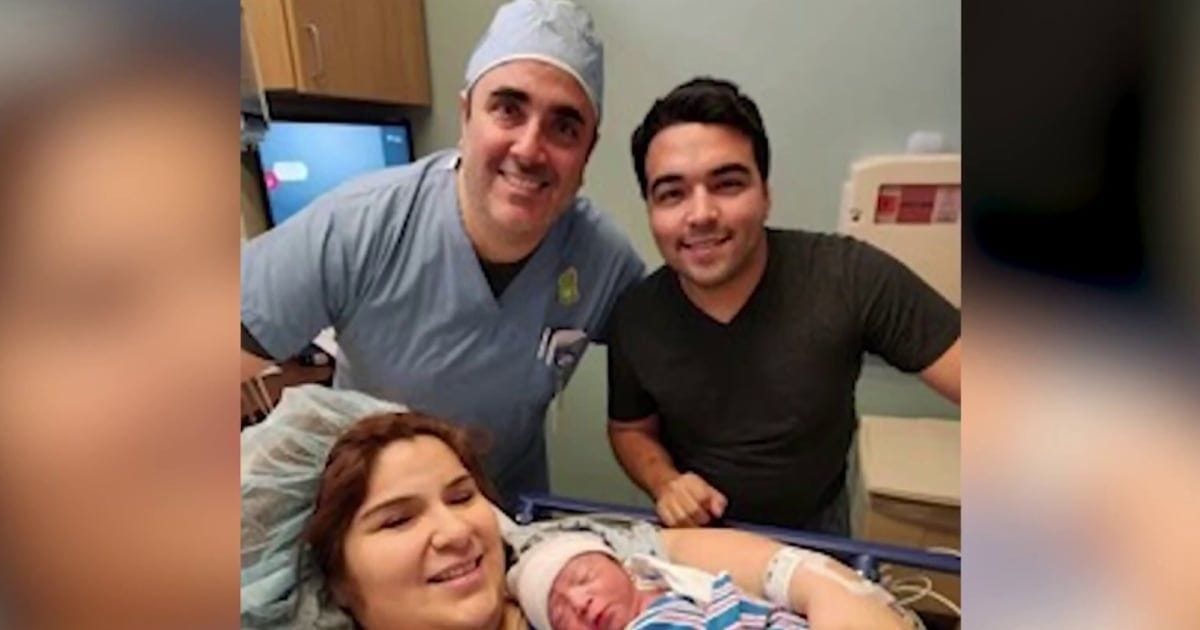JN.1 and its descendants continue to dominate both in the U.S. and globally. Hospitalizations and Emergency Department visits continue to decline, although national levels of SARS-CoV-2 in wastewater are still “HIGH”, mostly related to high levels in some southern states. Walgreen’s map of COVID positivity shows that there is a plateau or a decrease this week in virus positivity in many U.S. states. Mike Hoerger’s modeling shows that there are still about 650,000 new COVID cases each day in the United States and he expects this to decline to about 350,000 new cases daily by March 25, 2024. His data shows that the US, Canada and the UK are “following a similar pattern, though Canada and the U.K. appear to have peaked earlier, and are likely seeing earlier declines in transmission.”
The CDC’s new recommendations
On Friday afternoon, the CDC changed their isolation recommendations for COVID stating that if someone is COVID positive, but they do not have a fever and their symptoms (if they had them) are improving, they no longer need to isolate from others. This goes against what we know about COVID infections. Being positive on a rapid antigen home test for COVID means that the viral load is high enough that the person is contagious to others. The CDC said that for “simplicity”, they put COVID into the same category as the flu or RSV. But, COVID is not the flu.
The CDC said in their new recommendation that “Due to the effectiveness of protective tools and high degree of population immunity, there are now fewer hospitalizations and deaths due to COVID-19.” Hospitalizations and deaths from COVID are lower than earlier in the pandemic, but we see from the CDC’s curve below that COVID infections still cause significantly more hospitalizations and deaths than the flu or RSV.
From: CDC https://www.cdc.gov/respiratory-viruses/background/index.html#:~:text=CDC%20broadly%20defines%20Long%20COVID,weeks%2C%20months%2C%20or%20years.
Hospitalizations and deaths are not the only consequences of a COVID infection. The CDC admitted that “Although COVID-19 is becoming more similar to influenza and RSV in terms of hospitalizations and death over time, important differences remain, like the potential for these post-infection conditions” including Long COVID and other chronic diseases. Each new reinfection with COVID increases the risk for Long COVID, an awful, disabling disease for which there are no treatments. In the year after a COVID infection, there are increased risks of heart attacks, strokes, diabetes (both Type I and Type II diabetes) and many other debilitating diseases. A study this week shows that each COVID infection can cause people to lose IQ points representing cognitive decline.
We do not know the long term effects of repeated COVID infections on children. We do know that asymptomatic children who had prior COVID infections have been found to have SARS-CoV-2 virus lingering in their tonsils. Long COVID may affect fewer children than adults, but children can get Long COVID. What will happen to children who get COVID infections over and over again because the Center for Disease Control and Protection is no longer controlling or protecting children and adults from potentially disabling, chronic disease?
A new article this week shows that babies infected with SARS-CoV-2 are developmentally delayed when tested as toddlers at 18 to 24 months of age. Children under 6 months of age are not able to get a COVID vaccine. Without COVID testing or isolation, siblings may give a young infant COVID which could affect their development long term.
In their recommendations this week, the CDC also said, “Protective tools, like vaccines and treatments, that decrease risk of COVID-19 disease (particularly severe disease) are now widely available.” Vaccines only work if you actually get them. Only 22% of adults got the XBB.1.5 updated COVID vaccine so far this year. The CDC also wrote about their decision to stop isolation, “There is a high degree of population immunity against COVID-19. More than 98% of the U.S. population now has some degree of protective immunity against COVID-19 from vaccination, prior infection, or both.” A new study this week shows that "protection [against COVID infection] wanes rapidly and is entirely lost one year after the previous infection...The findings support considerable immune evasion by JN.1." The CDC is giving people a false sense of protection.
Acute COVID infections
Dr. Linsey Marr and her team at Virginia Tech are working on “a device that would let people sample air for the presence of COVID-19” before they decide to go into a restaurant or a movie. The human transferrin receptor (TfR) which is found on many cell membranes in the body was found to be an alternate receptor for SARS-CoV-2 to infect humans.
There have been fascinating recent studies on the gut microbiome’s effects on different diseases. We know that COVID infection can cause people to make blood clots. A new study in Cell Metabolism shows that when there are certain bacteria in the gut that make 2MBC (2-methylbutyryl carnitine), there is an increased risk of thrombosis and major adverse cardiovascular events (MACEs) such as stroke and heart attack. 2MBC directly binds an integrin molecule called α2β1 on platelets, making them hyper reactive and sticky. These activated platelets triggered by COVID infection can travel to other organs such as the heart or liver and cause blood clots and tissue damage. Giving mice antibiotics to knock out the gut bacteria that make 2MBC led to reduced risk of SARS-CoV-2 induced thrombosis.
Figure 7: Gut microbiota dysbiosis leads to abnormal accumulation of circulating 2MBC. 2MBC stimulates integrin α2β1 activation in platelets which turns on a cascade that makes platelets hypercoagulable so that they cause blood clots in other organs.
Two Marriage and Family Therapist trainees named Olivia Belknap and Erin Batali made an amazing presentation on “What therapists (MFTs) need to know about COVID and Long COVID”. Their presentation is important for many people to read, not just therapists, as they dove into the research on many pertinent topics including what is COVID, COVID’s impact on the brain and the body, social justice concerns, clinical implications and resources. Here is one of their slides on misconceptions and truths about COVID:
Seniors
Two days before the CDC changed isolation guidelines for COVID, they recommended that older adults age 65+ should get a spring COVID booster with the XBB.1.5 COVID vaccine. They discussed that every year there has been a COVID wave in the winter peaking in January and another in the summer peaking in August. Seniors should get the new booster four months after their last vaccine dose if they got one, or at least three months after a COVID infection. The CDC recommends that immunocompromised people may need additional booster doses as well.
Pediatrics
A new prospective observational cohort study shows that toddlers (age 18 to 24 months) that had COVID infections as infants have neurodevelopmental delays. SARS-CoV-2-positive babies who were tested as toddlers were found to have poorer psychomotor development index (PDI) scores and significantly greater mildly delayed performances (MDPs) at 18–24 months, especially with the Delta variant. These children were also found to have a smaller head circumference at age 1 (p < 0.001) that normalized by age 2. The authors recommended that children who had a COVID infection in the neonatal period be reevaluated with neurodevelopmental testing at age 5 and age 12 to see if they still have neurodevelopmental delays. I would recommend adding early intervention services as well.
Most children have mild COVID infections. But, looking specifically at 111 children who were hospitalized with SARS-CoV-2 infection and had neurologic symptoms such as encephalopathy or MIS-C, a meta-analysis shows that 44% of those hospitalized children with neurologic symptoms were found to have abnormal MRIs of the spine and brain.
A multicenter study shows that 30% of children who were previously hospitalized with COVID infection and/or MIS-C had not recovered by 31 to 54 months after discharge. The non-recovered children were more likely to have a high CRP level and a low lymphocyte count on admission to the hospital. The most common symptoms after COVID were fatigue, weakness, and headache. Of children in the not recovered group, 40% had at least one return emergency department visit, and 24% needed to be readmitted to hospital.
Long COVID and the Brain
There were two important studies reported in the New England Journal of Medicine this week on COVID and the brain. The first looked at 112,964 adults in England who underwent online cognitive testing. People who had an acute COVID infection but no Long COVID, had a small decrease in cognitive function. People with Long COVID had the largest cognitive defects in memory, reasoning, and executive function.
This study measured IQ points lost (cognitive deficit) as compared to uninfected controls and found:
3 IQ points loss for mild COVID infection, resolved
6 IQ points loss for Long COVID (symptoms not resolved)
9 IQ points loss for severe COVID with ICU stay
Additional 2 IQ points loss for COVID reinfection
COVID is bad for the brain.
A prospective study from Oslo, Norway compared 57,319 who tested positive for SARS-CoV-2 to 54,673 who tested negative for SARS-CoV-2 infection over time. People who had a positive COVID test were found to have worse memory function as assessed by the Everyday Memory Questionnaire (EMQ) at several different time points up to 36 months after a COVID infection.
The effects of COVID and Long COVID on the brain were reviewed by Eric Topol MD in his blog post entitled “Long Covid and Cognitive Deficits”and by Ziyad Al-Aly and Cliff Rosen in the NEJM. In their piece entitled “Long Covid and Impaired Cognition — More Evidence and More Work to Do”, Drs Al-Aly and Rosen discuss that fundamental features of Long COVID include fatigue, dysautonomia (postural orthostatic tachycardia syndrome), post exertional malaise, and cognitive difficulties. The authors summarized, “SARS-CoV-2 infection induces fusion of neurons, which compromises neuronal activity. Studies involving humans have shown prolonged neuroinflammatory responses, structural abnormalities, and accelerated aging in the brains of persons with mild-to-moderate SARS-CoV-2 infection. Virus was present in brain-tissue samples obtained during autopsy from persons who had had severe Covid-19. Gut dysbiosis, dysfunctional hypothalamic–pituitary response, and low-serotonin–induced dysfunction in vagal signaling may also play a role in impaired cognition after SARS-CoV-2 infection.” They also included this excellent drawing summarizing possible mechanisms leading to cognitive dysfunction in Long COVID.
Figure 1. Putative Mechanisms of Cognitive Dysfunction in Long Covid.
Dr. Al-Aly also wrote an amazing review, written for the general public, of important articles on COVID's effects on the brain including the 2 new articles from the NEJM. The article also linked to an excellent video summary on COVID-19’s impact on the brain from Science magazine (2022). The article reviews changes in the brain from COVID including loss of brain volume, increased aging of the brain, fusion of brain neurons, disruption of the blood-brain barrier and increased risk of dementia after COVID infection.
On February 26, a front page article (above the fold) in USA Today looked at Long COVID and how there are still zero proven treatments for this disabling disease. Sawyer Blatz spoke about how Long COVID patients feel abandoned. Dr. Putrino, of Mount Sinai, discussed how Long COVID patients’ conditions are very complex and clinical studies should focus on more than one treatment at a time. He recommends trials of combination therapies for Long COVID.
I came across a thread on Reddit in which COVID long haulers discussed how they found themselves doing strange things reflective of their cognitive dysfunction such as taking a shower with their socks on. One person wrote this about some of her Long COVID “brain fog” moments:
I am concerned that some people may not know that they have cognitive dysfunction from a milder case of Long COVID. This could be dangerous if they are driving or doing other tasks.
When my family member first was seen in neurology for Long COVID, the neurologist told us that there were no treatments for Long COVID brain fog and that I should go online to patient forums to see what worked for other people. In my notes below, I have included several links to tweet threads where people with Long COVID discussed what medications, supplements or other treatments helped them the most. In 2023, @LongCOVIDPharmD made a survey for people with Long COVID and ME/CFS about many different medications and supplements including:
From: pharmD.substack.com
This week, new data was released from the CDC Household Pulse survey conducted January 9, 2024 through February 5, 2024. It showed that 6.8% of adults currently have Long COVID, up from 5.3% in October 2023. The new survey also showed that 17.6% of adults have now experienced Long COVID, compared to 14.3% in October 2023.
Source: https://www.cdc.gov/nchs/covid19/pulse/long-covid.htm
An article in Bloomberg this week looked at the increase in cardiovascular and metabolic illness (diabetes) resulting in a rise in deaths for the last 4 years. 250,000 more people died of cardiovascular disease than expected from 2020 to 2022. Compared to pre-pandemic levels, there was also a 5% increase in stroke mortality. Countries like Japan that have low obesity rates have also seen an increase in cardiovascular deaths linked to COVID infections.
From: https://www.bloomberg.com/news/articles/2024-02-26/covid-made-heart-disease-deadlier-puzzling-scientists
In non-COVID news, Alabama lawmakers ruled to protect in vitro fertilization (IVF) services this week after fertility clinics shut down in the wake of a state court ruling stating that frozen embryos are “extrauterine children”. More than 10,000 intern and resident doctors in South Korea have resigned over government changes. The Florida State Health Department released a letter recommending against isolation and vaccination of children exposed to measles. Katelyn Jetelina reviewed why this is a very bad idea. Measles is exceptionally contagious and people can spread the virus up to 21 days after exposure, so isolation is very important. An unvaccinated person can get the vaccine within 72 hours of exposure to reduce the risk of severe disease, but the Florida State Health Department is not recommending this.
It turns out that gut bacteria can go through leaky epithelial cells in the colon to the bloodstream. From there, these bacteria can travel to the retina where they can get inside the eye if the retina-blood barrier is weakened as well. Some eye diseases, like retinitis pigmentosa, may not be purely genetic after all and antibiotics may help to treat these blinding eye diseases.
A new study shows that Xolair can be used to reduce life-threatening allergic reactions in children to traces of food allergens like peanuts or eggs. Treatment with Xolair could allow children to fly on airplanes or go to restaurants and could be life changing. Omalizumab (Xolair) is a monoclonal anti-IgE antibody.
Another drug, Singulair (montelukast), which is used for asthma is being looked at for stricter warnings. “Thousands of patients and parents have complained to the F.D.A. about symptoms of anxiety, rage, hallucinations and other psychiatric problems that they linked to the drug [Singulair].”
Medical students at the Albert Einstein College of Medicine in the Bronx, New York got a huge surprise this week. Professor Dr. Gottesman donated $1 Billion so that students can attend the medical school tuition free in perpetuity.
New Jersey doctor Eric Grossman delivered babies on his 13th birthday this week. It turns out that Dr. Grossman was born on leap day in 1972 and he helped deliver the next group of leap year babies on February 29th. In Missouri, a pregnant woman broke her water at 35 weeks, just days before her scheduled wedding. The nurses at the hospital made her a wedding dress out of hospital sheets and found another new dad who was an ordained minister to marry them. The couple said “I do” in between contractions and their baby boy arrived several hours later.
Have a great rest of your weekend,
Ruth Ann Crystal MD
COVID news notes:
US Variant tracker: https://covid.cdc.gov/covid-data-tracker/#variant-proportions
JN.1 and its descendants dominate
Variants in locations around the globe: https://outbreak.info/
CDC COVID data tracker: https://covid.cdc.gov/covid-data-tracker/index.html#datatracker-home
CDC COVID Hospitalizations (blue) and Emergency Room (orange) visits tracker: https://covid.cdc.gov/covid-data-tracker/index.html#trends_weeklyhospitaladmissions_7dayeddiagnosed_00
Weekly ED visits for respiratory illnesses, by age and disease: https://www.cdc.gov/ncird/surveillance/respiratory-illnesses/index.html
Walgreens positivity rate: https://www.walgreens.com/businesssolutions/covid-19-index.jsp
US Wastewater Monitoring:
CDC wastewater reporting: https://www.cdc.gov/nwss/rv/COVID19-nationaltrend.html
The South and the Midwest appear to have plateaued.
CDC wastewater map: https://www.cdc.gov/nwss/rv/COVID19-currentlevels.html
Biobot: https://biobot.io/data/
National SARS-CoV-2 data from Sara Anne Willette: https://iowacovid19tracker.org/
Wastewater:
Wastewater SCAN: https://data.wastewaterscan.org/
California statewide view https://buff.ly/3YObiul
From Violet Blue https://www.patreon.com/posts/pandemic-roundup-99442377
Sewer Coronavirus Alert Network (SCAN) project by Stanford University:
Santa Clara County wastewater: https://covid19.sccgov.org/dashboard-wastewater
Marin county: https://coronavirus.marinhhs.org/surveillance
CDC Respiratory vaccination trends: https://www.cdc.gov/respiratory-viruses/data-research/dashboard/vaccination-trends-adults.html
COVID vaccine (XBB.1.5): 22%
Flu 47.7%
RSV 22.4%
JP Weiland: https://twitter.com/JPWeiland
JN.1 is dominant worldwide
https://twitter.com/RajlabN/status/1761565651150246235
Michael Hoerger modeling: http://pmc19.com/data/
https://twitter.com/michael_hoerger/status/1763060938561736795
PMC COVID-19 Forecast, Week of Feb 26, 2024 from Mike Hoerger:
Forecast for the next month
Over the next month, we should see transmission fall from 790,000 infections/day toward more like a range of 200,000-450,000 infections per day, depending on better or worse scenarios.
Current State of the Pandemic
73 million infections in the U.S. in 2024 (so far)
790,000 daily infections
1.66% (1 in 60) actively infectious
40,000+ resulting #LongCOVID cases/day
Deeper Dive
Transmission is finally starting to decline again, and expect major declines in the next four weeks.
International Comparisons
The percentage of the U.S. actively infectious (1.7%) is very much in line with recent high-quality estimates for Canada (2.1%) and the U.K. (1.5%).
All three countries are following a similar pattern, though Canada and the U.K. appear to have peaked earlier, and are likely seeing earlier declines in transmission. Note that their numbers are marginally more delayed.
Acute COVID infections, General COVID info
3/1/24 https://www.cdc.gov/media/releases/2024/p0301-respiratory-virus.html
“The new guidance brings a unified approach to addressing risks from a range of common respiratory viral illnesses, such as COVID-19, flu, and RSV, which can cause significant health impacts and strain on hospitals and health care workers. CDC is making updates to the recommendations now because the U.S. is seeing far fewer hospitalizations and deaths associated with COVID-19 and because we have more tools than ever to combat flu, COVID, and RSV.”
https://www.cdc.gov/mmwr/volumes/71/wr/mm7121e1.htm?s_cid=mm7121e1_w
From CDC MMWR 5/24/2022: https://www.cdc.gov/mmwr/volumes/71/wr/mm7121e1.htm?s_cid=mm7121e1_w
Would the CDC do this for Tuberculosis, for Measles, or other respiratory diseases? COVID is not the flu or RSV and should not be lumped in this category. If a person tests positive for COVID, common sense tells us that they should stay home until they are no longer contagious.
https://twitter.com/JPWeiland/status/1763989777827733672
https://twitter.com/Billius27/status/1763994003949617638
12/2/22 Nature Reviews Microbiology: SARS-CoV-2 viral load and shedding kinetics https://buff.ly/3iD5TFd
https://www.nature.com/articles/s41579-022-00822-w
10/10/22 JAMA: COVID-19 Symptoms and Rapid Antigen Test Positivity at a Community Testing Site https://buff.ly/49UTty6
"Rapid antigen test positivity remained high 5 days after symptom onset, supporting guidelines requiring a negative test to inform the length of the isolation period."
CDC’s reasoning for dropping isolation:
3/1/24 CDC: Background for CDC's Updated Respiratory Virus Guidance | Respiratory Illnesses https://buff.ly/49YdJyz.
“Due to the effectiveness of protective tools and high degree of population immunity, there are now fewer hospitalizations and deaths due to COVID-19.”
There are still a lot more hospitalizations and deaths than for the flu or RSV.
CDC: “Protective tools, like vaccines and treatments, that decrease risk of COVID-19 disease (particularly severe disease) are now widely available.”
Only 22% of adults got the XBB.1.5 updated vaccine. The vaccines only work if you actually get them.
https://www.cdc.gov/respiratory-viruses/data-research/dashboard/vaccination-trends-adults.html
COVID vaccine (XBB.1.5): 22%
Flu 47.7%
RSV 22.4%
CDC: “There is a high degree of population immunity against COVID-19. More than 98% of the U.S. population now has some degree of protective immunity against COVID-19 from vaccination, prior infection, or both.”
2/23/24 MedRxiV (Cornell Qatar): Protection of natural infection against reinfection with SARS-CoV-2 JN.1 variant https://buff.ly/3Igvuh4
"The protection wanes rapidly and is entirely lost one year after the previous infection.... The findings support considerable immune evasion by JN.1."
"The overall effectiveness of previous infection in preventing reinfection with JN.1 was estimated at only 1.8%."
From this CDC explainer
3/1/24 Background for CDC's Updated Respiratory Virus Guidance | Respiratory Illnesses | CDC https://buff.ly/49YdJyz.
2/27/24 WTOP: Rapid test could detect COVID-19 in air before you go to movie, dine out https://buff.ly/49RLwJL
“Researchers at Virginia Tech are working on a device that would let people sample air for the presence of COVID-19, before deciding whether to enter a business or facility, per Dr. Linsey Marr, professor of civil and environmental engineering at Virginia Tech.”
2/23/24 Cell Metabolism (Guangdong, China): Gut microbial co-metabolite 2-methylbutyrylcarnitine (2-MBC) exacerbates thrombosis via binding to and activating integrin α2β1 https://buff.ly/3v2G8Vr
2MBC is a metabolite that links gut microbiota dysbiosis to elevated thrombotic risk and increased risk of major adverse cardiovascular events (MACEs) such as stroke and heart attack.
2-methylbutyrylcarnitine (2MBC), a branched-chain acylcarnitine, is accumulated in patients with COVID-19 and in patients with MACEs.
Summary:
2MBC accumulation leads to increased thrombotic risk.
2MBC directly binds to integrin α2β1 and potentiates platelet hyperreactivity.
Inhibition of integrin α2β1 ameliorates 2MBC-induced heightened thrombotic risk.
2MBC is a co-metabolite bridging gut microbiota dysbiosis and thrombosis.
Viral infection induced vascular thrombosis in lung, heart, and liver of hACE2 mice, whereas this tendency was largely ameliorated following antibiotic-induced microbial depletion.
Figure 7: Gut microbiota dysbiosis leads to abnormal accumulation of circulating 2MBC. 2MBC directly binds to and potentiates integrin α2β1 activation in platelets under the stimulation of agonists, which promotes cPLA2-mediated TXA2 generation and platelet hyperresponsiveness, thus increasing the thrombotic tendency in the host.
2/26/24 PNAS: Human transferrin receptor can mediate SARS-CoV-2 infection https://buff.ly/3OXMAnI
Human transferrin receptor (TfR), one of the most ubiquitously and highly expressed membrane components, is an alternate receptor for SARS-CoV-2.
2/23/24 MedRxiV (Cornell Qatar): Protection of natural infection against reinfection with SARS-CoV-2 JN.1 variant https://buff.ly/3Igvuh4
"The protection wanes rapidly and is entirely lost one year after the previous infection.... The findings support considerable immune evasion by JN.1."
"The overall effectiveness of previous infection in preventing reinfection with JN.1 was estimated at only 1.8%."
Effectiveness of prior COVID infection protecting against JN.1:
82% at 3 to 6 months after last COVID infection
51% from 6 to 9 months
18% from 9 months to 1 year
Negligible after 1 year.
What therapists (MFTs) need to know about COVID and Long COVID by Olivia Belknap and Erin Batali, Marriage and Family Therapist Trainees. Olivia has Long COVID.
https://covid-for-therapists.my.canva.site/
Seniors
2/28/24 NBC: CDC recommends spring Covid booster for older adults (age 65 and older) https://buff.ly/3Titr2a
“Over the past four years, there’s tended to be both a winter and a summer wave of Covid, with cases peaking in January and August, respectively, according to the CDC.
The additional dose should be given at least four months after a previous dose for healthy older adults, or at least three months after a Covid infection. People with compromised immune systems may need additional shots.”
Pediatrics
2/27/24 Italian Journal of Pediatrics (Turkey): The long-term neurodevelopmental outcomes of toddlers with SARS-CoV-2 infection in the neonatal period: a prospective observational study https://buff.ly/4bOZIFg
n = 30 babies with COVID infection from Jan 2021 to Jan 2022 (11 babies had Delta infection and 19 did not have a Delta SARS-CoV-2 infection) vs 60 controls hospitalized in the NICU for other reasons
Prospective observational cohort study
Neurodevelopment was evaluated between the ages of 18 and 24 months using the Bayley-II scale.
Results:
SARS-CoV-2-positive infants had poorer psychomotor development index (PDI) scores and significantly greater mildly delayed performances (MDPs) at 18–24 months, especially with the Delta variant.
A smaller head circumference of SARS-CoV-2-positive toddlers was found in the first year (p < 0.001), which improved by age 2.
Authors recommend children who had a COVID infection in the neonatal period be reevaluated with neurodevelopmental testing at age 5 and age 12.
2/27/24 Nature: Neuroimaging findings in children with COVID-19 infection: a systematic review and meta-analysis https://buff.ly/42VNnex
Most of the literature on COVID-19-related neuroimaging findings in children has consisted of case reports.
Authors looked at 96 studies, but only analyzed 5 studies with a total of 111 children hospitalized with COVID infection complicated by neurologic symptoms.
43.7% of these hospitalized children with neurologic symptoms (encephalopathy, MIS-C, etc) had abnormal neuroimaging findings of the spine and brain.
2/12/24 Frontiers in Pediatrics: Post-discharge outcomes of hospitalized children diagnosed with acute SARS-CoV-2 or MIS-C https://buff.ly/3Il6mWm
30% of parents (23 out of 79) reported that their child had not recovered from COVID-19 and/or multisystem inflammatory syndrome in children (MIS-C), a rare but serious complication that can occur after COVID-19.
Of children in the not recovered group, 40% had at least one return emergency visit, and 24% were readmitted to hospital.
Admission C-reactive protein levels were higher in children not recovered vs. recovered [5.7 (1.3, 25.1) vs. 1.3 (0.4, 6.3) mg/dl, p = 0.02].
At follow-up, 67% overall had new or persistent symptoms. The most common symptoms were fatigue (37%), weakness (25%), and headache (24%), all with frequencies higher in children not recovered.
Long COVID
https://twitter.com/seeksboston26mi/status/1763299116765905015
https://twitter.com/seeksboston26mi/status/1761159566970998815
/photo/1
Long COVID and Cognitive Problems:
2/29/24 NEJM: Cognition and Memory after Covid-19 in a Large Community Sample https://buff.ly/3uUA2Xm
112,964 adults in England underwent online cognitive testing.
People who had an acute COVID infection but no Long COVID, had a small decrease in cognitive function.
People who had Long COVID after an acute COVID infection, had the largest cognitive defects in memory, reasoning, and executive function.
IQ points lost (cognitive deficit) as compared to uninfected controls:
3 points loss for mild COVID, resolved
6 points loss for Long COVID (symptoms not resolved)
9 points loss for severe COVID with ICU stay
Additional 2 points lost for COVID reinfection
2/29/24 NEJM (Oslo U, Norway): Prospective Memory Assessment before and after Covid-19 https://buff.ly/3uYMQM8
57,319 tested positive for SARS-CoV-2 vs. 54,673 tested negative for SARS-CoV-2 infection.
Memory function was assessed by Everyday Memory Questionnaire (EMQ) before and after COVID testing.
The adjusted mean EMQ scores were numerically higher (indicating worse memory problems) after a positive COVID test than after a negative test at all time points.
"In a group of Norwegian participants assessed between March 2020 and April 2023, participant-reported memory function, as scored on the EMQ, was numerically worse at several time points up to 36 months after a positive SARS-CoV-2 test than after a negative test."
2/29/24 NEJM (Z. Al-Aly & C. Rosen): Long Covid and Impaired Cognition — More Evidence and More Work to Do https://buff.ly/48BJ9Kh
See Figure 1 below for summary
The cardinal features of long Covid include fatigue, dysautonomia (or postural orthostatic tachycardia syndrome), post exertional malaise, and cognitive difficulties that are colloquially referred to as “brain fog.”
England study above:
“The greatest deficits in cognitive function were associated with the original strain of the virus (before December 1, 2020) and the early B.1.1.7 (alpha) variant (from December 1, 2020, to April 30, 2021). Longer hospital stays and durations of acute illness were predictors of persistent global deficits.
Vaccinations provided a small cognitive advantage.
How SARS-CoV-2 affects the brain:
“SARS-CoV-2 infection induces fusion of neurons, which compromises neuronal activity. Studies involving humans have shown prolonged neuroinflammatory responses, structural abnormalities, and accelerated aging in the brains of persons with mild-to-moderate SARS-CoV-2 infection. Virus was present in brain-tissue samples obtained during autopsy from persons who had had severe Covid-19. Gut dysbiosis, dysfunctional hypothalamic–pituitary response, and low-serotonin–induced dysfunction in vagal signaling may also play a role in impaired cognition after SARS-CoV-2 infection.”
Figure 1. Putative Mechanisms of Cognitive Dysfunction in Long Covid.
Summary of brain and neuron damage caused by SARS-CoV-2
Figure 1: The putative mechanisms of cognitive dysfunction in long Covid include viral persistence, activation of complement and platelet aggregation leading to microthrombosis and fusion of neurons and glial cells, neuroinflammation and impaired neurogenesis, and low-serotonin–induced dysfunction in vagal signaling. CRH denotes corticotropin-releasing hormone.
2/28/24 Eric Topol MD: Long Covid and Cognitive Deficits https://buff.ly/3UZBAK9
Review of English study, Norwegian study below and others.
2/28/24 The Conversation by Ziyad Al-Aly: Mounting research shows that COVID-19 leaves its mark on the brain, including with significant drops in IQ scores https://buff.ly/3P4hIls
Amazing review, written for the general public, of important articles on COVID's effects on the brain including the 2 new articles from the NEJM (England and Norway).
Includes an important video summary from Science magazine from 2022 https://buff.ly/3TiBjko
cognitive dysfunction, brain fog, Long COVID, PASC
Important articles on COVID and the brain discussed:
Here are some of the most important studies to date documenting how COVID-19 affects brain health:
Large epidemiological analyses showed that people who had COVID-19 were at an increased risk of cognitive deficits, such as memory problems.
Imaging studies done in people before and after their COVID-19 infections show shrinkage of brain volume and altered brain structure after infection.
A study of people with mild to moderate COVID-19 showed significant prolonged inflammation of the brain and changes that are commensurate with seven years of brain aging.
Severe COVID-19 that requires hospitalization or intensive care may result in cognitive deficits and other brain damage that are equivalent to 20 years of aging.
Laboratory experiments in human and mouse brain organoids designed to emulate changes in the human brain showed that SARS-CoV-2 infection triggers the fusion of brain cells. This effectively short-circuits brain electrical activity and compromises function.
Autopsy studies of people who had severe COVID-19 but died months later from other causes showed that the virus was still present in brain tissue. This provides evidence that contrary to its name, SARS-CoV-2 is not only a respiratory virus, but it can also enter the brain in some individuals. But whether the persistence of the virus in brain tissue is driving some of the brain problems seen in people who have had COVID-19 is not yet clear.
Studies show that even when the virus is mild and exclusively confined to the lungs, it can still provoke inflammation in the brain and impair brain cells’ ability to regenerate.
COVID-19 can also disrupt the blood brain barrier, the shield that protects the nervous system – which is the control and command center of our bodies – making it “leaky.” Studies using imaging to assess the brains of people hospitalized with COVID-19 showed disrupted or leaky blood brain barriers in those who experienced brain fog.
A large preliminary analysis pooling together data from 11 studies encompassing almost 1 million people with COVID-19 and more than 6 million uninfected individuals showed that COVID-19 increased the risk of development of new-onset dementia in people older than 60 years of age.
A recent analysis of the U.S. Current Population Survey showed that after the start of the COVID-19 pandemic, an additional 1 million working-age Americans reported having “serious difficulty” remembering, concentrating or making decisions than at any time in the preceding 15 years. Most disconcertingly, this was mostly driven by younger adults between the ages of 18 to 44.
Data from the European Union shows a similar trend – in 2022, 15% of people in the EU reported memory and concentration issues.
4/15/2022 Science magazine video: Here’s what we know about COVID-19’s impact on the brain https://buff.ly/3TiBjko
2/29/24 Wolfgang Hagen: Long Covid, die Blut-Hirn-Schranke und das Immunsystem (Long Covid, the blood-brain barrier and the immune system) https://buff.ly/3wHtmfu
Great summary of recent findings in Long COVID.
Permeable blood-brain barrier in LC with brain fog and cognitive dysfunction, complement system activation which damages endothelial cells and causes microclots, prolonged elevation of interferon-γ in Long COVID.
2/27/24 Healio: ‘Frightening’ connections between long COVID, fibromyalgia, fatigue warrant more research says Leonard Calabrese, DO https://buff.ly/42X669y
"According to Calabrese, a study from the Post-Acute COVID-19 Syndrome Clinic at Stanford University produced one “pretty frightening” data point, when researchers led by Hector F. Bonilla, MD, found that 43% of 140 patients referred there met Institute of Medicine criteria for myalgic encephalomyelitis/chronic fatigue syndrome (ME/CFS). He cautioned that the sample was “very highly biased” and not population-based, but added the result suggests COVID-19 has the capacity to “make people display the features that meet fairly widely accepted criteria for ME/CFS.”
2/26/24 USA Today: Millions of Americans suffer from long COVID. Why do treatments remain out of reach? https://buff.ly/49xBIVw
Featuring Sawyer Blatz of Long COVID Moonshot and Dr. Ziyad Al-Aly of VA St. Louis.
There are still “zero” proven treatments for Long COVID.
"Long COVID patients' conditions are some of the most complicated he’s ever seen." - Dr. Putrino
https://twitter.com/ahhrrr/status/1763017632926810611
Link to CDC: https://www.cdc.gov/nchs/covid19/pulse/long-covid.htm
2/26/24 Bloomberg: A Spike in Heart Disease Deaths Since Covid Is Puzzling Scientists https://buff.ly/3wHczsX
Increased CV and metabolic illness causing a rise in deaths for the last 4 years.
250,000 more people died of CV disease than expected from 2020 to 2022.
Compared to pre-pandemic levels, there was a 5% increase in stroke mortality.
Deaths related to hypertensive heart disease, rhythm abnormalities, blood clots, diabetes and kidney failure were 15-28% higher.
Even countries like Japan, with the lowest prevalence of overweight and obesity in the developed world, registered an uptick in cardiovascular deaths linked to Covid.
The SARS-CoV-2 virus can directly infect certain heart tissues, including coronary vessels, to cause inflammation of the fatty plaque inside arteries.
https://twitter.com/JanetDafoe/status/1762443961816539137
From Reddit r/covidlonghaulers
“Before Covid I had never gotten into the shower with my socks on. What are some of your funny "WTF" moments?”. Here is one of the responses regarding brain fog:
2/27/24 TIME: There's No Universal Case of Long COVID https://buff.ly/3SXL99K
“Challenges of detecting, diagnosing, and treating Long COVID. It affects people from all walks of life and produces a vast array of symptoms that can range in severity from mild to life-altering. And because there are so many forms Long COVID can take, it can be difficult for patients and doctors to know what’s going on.”
Thread on treatments, supplements that helped Long COVID patients
https://twitter.com/healingfromlc/status/1762960524474499551
Threads and surveys on what medications or supplements helped LC patients:
Organichemusic survey: https://twitter.com/organichemusic/status/1574343046946328576
02. January 2024
https://twitter.com/healingfromlc/status/1742269803690103256
18. September 2023
https://twitter.com/cstroeckw/status/1704006880824066304
03 Dec 2023
https://twitter.com/CovidCastaways/status/1731451569650979185
17 Dec 2023
https://twitter.com/Gmwetz/status/1736425600141676842
16 Feb 2024
https://twitter.com/erincandy/status/1758505986615111997
16 July 2023
2/27/24 Nature: Speed up relief for long COVID through grassroots clinical trials https://buff.ly/3P0b2ot
The authors propose a ‘grassroots’ system with clinician-patient pairs working with researchers to avoid “problems that can plague clinical trials: low enrolment, late or missing trial reporting and faked or fatally flawed results.”
AI:
2/27/24 Adapted large language models can outperform medical experts in clinical text summarization - Nature Medicine https://buff.ly/3TdK4fg
LLM summaries were preferred over physician summaries for completeness, correctness, and conciseness of medical notes.
"This suggests that incorporating LLM-generated candidate summaries could reduce documentation load, potentially leading to decreased clinician strain and improved patient care."
AI deep fakes teach math on TikTok
Drake and Queen Elizabeth:
@onlocklearningDrake and Lizzie vibe out to some TRIGONOMETRY🔥 I know there’s WAYYYY more to trigonometry (like understanding it using the unit circle and stuff), and we’ll get to that in the future🫡 ⚠️DISCLAIMER⚠️: This is not real audio/video of Drake or Queen Elizabeth II. All video and speech was computer generated to help others learn about maths, physics, and engineering. All background music (in order): Passion Fruit - Drake Prolly my spookiest beat - PRODBY668 KALEO - Way Down We Go #trigonometry #maths #engineering #physicsTiktok failed to load.
Enable 3rd party cookies or use another browser
Other news:
Bride in labor gets married in wedding gown of hospital’s ‘finest sheets’ | CNN https://buff.ly/4bWnjEa
2/29/24 NBC: Doctor born on leap day 1972 welcomes next generation of leap babies https://buff.ly/4bUztgO
“On his 13th birthday, Dr. Eric B. Grossman, a New Jersey OBGYN who was born on leap day in 1972, helped deliver the next generation of leap year babies and offered up some advice for parents on the birthday dilemma.”
2/29/24 NPR: Alabama Legislature moves to protect IVF services after state court ruling https://buff.ly/4caFKVV
2/29/24 NY Times: What to Know About the Doctor Protests in South Korea https://buff.ly/49K286w
10,000 doctors, mostly interns and residents, have resigned.
2/27/24 Katelyn Jetelina: Florida’s recommendations give room for measles to spread https://buff.ly/3UQ9Vvb
The Florida State Health Department released a letter with a surprising new recommendation that contradicts standard of practice guidelines for measles outbreaks in two big ways: isolation and vaccination.
Measles is exceptionally contagious and people can spread the virus up to 21 days after exposure. Therefore they should isolate for 21 days. Also, if exposed, an unvaccinated person can get the vaccine within 72 hours to reduce the risk of severe disease.
2/26/24 Nature: The surprising link between gut bacteria and devastating eye diseases https://buff.ly/3UYlLDG
Eye diseases long thought to be purely genetic might be caused in part by bacteria that escape the gut and travel to the retina, research suggests. Could antibiotics help treat eye diseases like retinitis pigmentosa (mutations in the gene Crumbs homolog 1 (CRB1)?
2/26/24 Cell: CRB1-associated retinal degeneration is dependent on bacterial translocation from the gut https://buff.ly/3ToZk9z
“Our data elucidate the pathogenesis of Crb1-mutation-associated retinal degenerations and suggest that antimicrobial agents have the potential to treat this devastating blinding disease.”
Graphical abstract:
2/26/24 Albert Einstein College of Medicine Announces Free Tuition in Perpetuity for All Medical School Students https://buff.ly/3SW26BH
2/26/24 NY Times: $1 Billion Donation Will Provide Free Tuition at Albert Einstein College of Medicine in the Bronx, NY https://buff.ly/3uMCcYQ
“While her husband ran an investment firm, First Manhattan, Dr. Gottesman had a long career at Einstein, a well-regarded medical school, starting in 1968, when she took a job as director of psychoeducational services. She has long been on Einstein’s board of trustees and is currently the chair.”
2/25/24 NY Times: Drug Drastically Reduces Children’s Reactions to Traces of Food Allergens https://buff.ly/3T95dr8
Xolair, has already been approved by the FDA for adults and children over age 1 with food allergies.
2/25/24 NEJM: Omalizumab for the Treatment of Multiple Food Allergies https://buff.ly/49NGOwN
Omalizumab (Xolair) is a monoclonal anti-IgE antibody.
2/22/24 NY Times: N.Y. Attorney General Urges Stricter Warnings for Asthma Drug Singulair https://buff.ly/49sqL7Q
“Thousands of patients and parents have complained to the F.D.A. about symptoms of anxiety, rage, hallucinations and other psychiatric problems that they linked to the drug” Singulair (montelukast).





